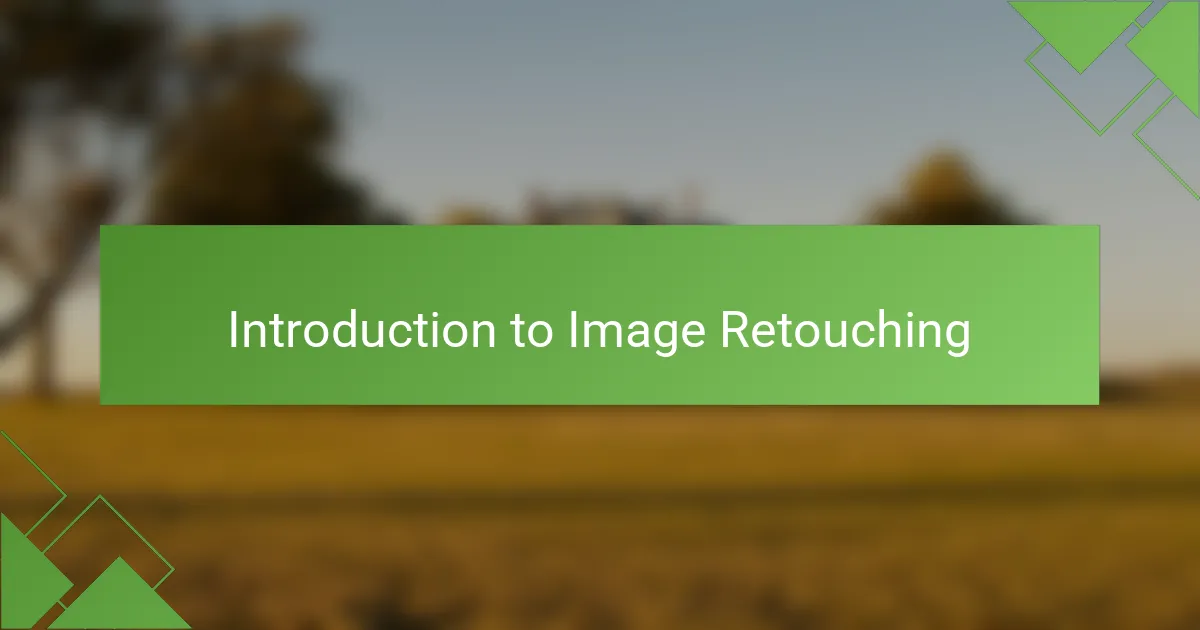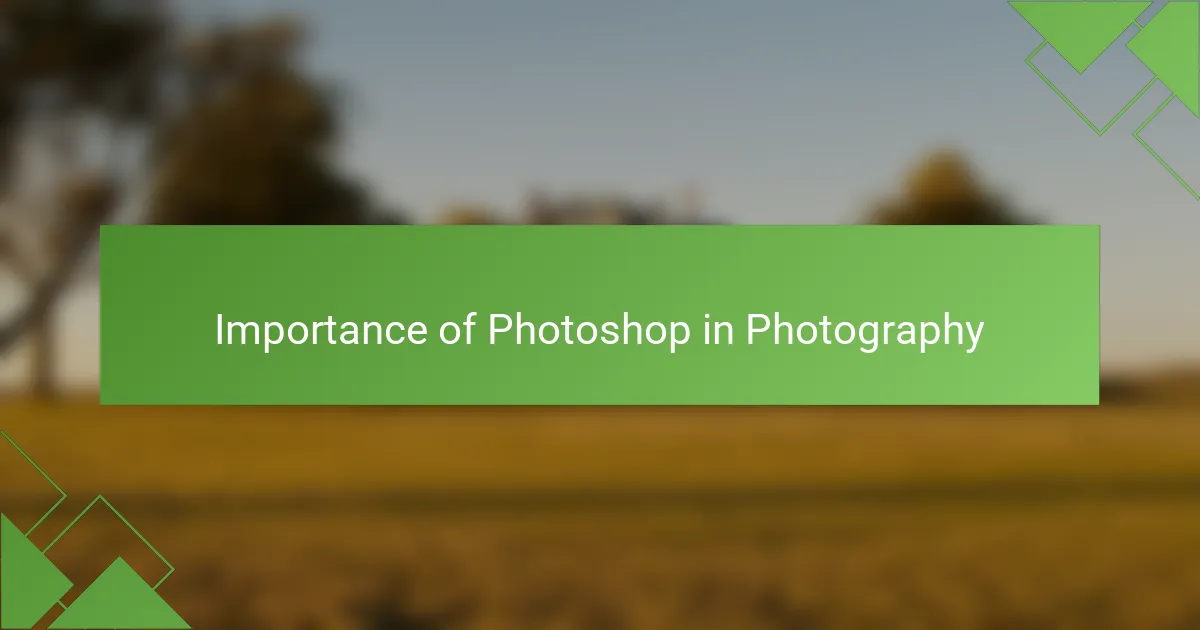Key takeaways
- Image retouching balances enhancement with authenticity, focusing on storytelling and emotion.
- Common retouching tools include the Healing Brush, Clone Stamp, and adjustment layers for non-destructive edits.
- A systematic step-by-step approach simplifies the retouching process and enhances creativity.
- Subtle adjustments and continuous learning are key to effective retouching while preserving the subject’s natural beauty.

Introduction to Image Retouching
Image retouching is an art form that transforms photographs from good to stunning, often revealing a vision that resonates with the photographer’s intent. I remember the first time I used Photoshop; it felt like magic when I could enhance colors and refine details to truly capture the subject’s essence. Have you ever looked at a photograph and wondered how those images managed to look so flawless?
When I started out, I often struggled to find the right balance between enhancing an image and preserving its authenticity. Over time, I discovered that the key lies in subtlety—each adjustment should subtly elevate the work without losing its original charm. It’s fascinating how a small tweak can breathe new life into a photo, isn’t it?
In the journey of retouching, embracing the creative process is just as important as mastering the technical aspects. I often explore new techniques by experimenting with tools and layers, finding joy in the unexpected results. Ultimately, image retouching is not just about perfection; it’s about storytelling and expressing emotion through visual art.

Importance of Photoshop in Photography
Photoshop holds a pivotal place in modern photography, acting as a powerful tool that can enhance creative vision and elevate an image from good to stunning. I remember when I first began exploring photography—I was fascinated by how I could reshape reality and accentuate the beauty in everyday moments. The ability to manipulate images not only empowers the artist but also allows for storytelling that captures emotion and evokes connection.
Moreover, with Photoshop, editing becomes an essential part of a photographer’s workflow, helping to address imperfections or bring out the hidden details that might go unnoticed in the raw shot. For me, it’s like a canvas where I can paint my interpretation of a scene, ensuring that each photo reflects my unique perspective and the emotions I felt in that moment.
| Feature | Photoshop |
|---|---|
| Image Editing | Robust tools for retouching, color correction, and applying special effects. |
| User Flexibility | Allows for creative expression through layers, brushes, and customizations. |
| Learning Curve | Initially complex, but rewarding as you master techniques and improve your artistry. |

Basic Tools for Image Retouching
When it comes to retouching images, I find that mastering a few basic tools in Photoshop can vastly improve the overall quality of your work. The Healing Brush, for instance, is my go-to for removing blemishes and imperfections. I love how it allows me to blend in with the surrounding texture seamlessly, creating a polished look that feels natural.
Another tool I often rely on is the Clone Stamp. While it may sound simple, this tool has brought my creative visions to life by allowing me to duplicate and manipulate specific areas of an image. I still remember the first time I used it—transforming a simple landscape shot into something magical by enhancing the clouds.
Lastly, don’t underestimate the power of adjustment layers. They provide non-destructive edits, letting me play with color, exposure, and contrast without permanently altering the original image. It’s freeing to explore different looks while always having the safety net of the original.
| Tool | Description |
|---|---|
| Healing Brush | Repairs imperfections by blending in surrounding pixels. |
| Clone Stamp | Duplicates selected areas to create desired adjustments. |
| Adjustment Layers | Allows non-destructive edits for color, exposure, and contrast. |

Common Retouching Techniques
When it comes to retouching images in Photoshop, several common techniques stand out for their effectiveness. I often start with basic adjustments, like correcting exposure and color balance, which can dramatically enhance the mood of a photograph. For instance, one time, I had a stunning shot of a sunset, but the colors felt washed out; a simple tweak in saturation brought the emotions I felt at that moment back to life.
Another key technique is skin retouching, which I approach with care. My aim is always to maintain the subject’s natural beauty while smoothing out imperfections. Using tools like the Healing Brush and Frequency Separation allows me to achieve a polished yet authentic look. Each time I see the final image, I feel a sense of pride, knowing I’ve captured more than just a face; I’ve preserved the essence of that person.
Lastly, I can’t emphasize enough the importance of cropping and framing. This technique can elevate a photograph from ordinary to extraordinary. I remember a portrait I took during a street photography session; after experimenting with cropping, the new composition highlighted the subject’s expression, making it far more impactful.
| Technique | Description |
|---|---|
| Color Correction | Adjusting exposure and color balance for mood enhancement. |
| Skin Retouching | Smoothing and enhancing skin while keeping natural beauty. |
| Cropping | Framing the subject to create a more powerful composition. |

Step-by-Step Retouching Process
When it comes to retouching images in Photoshop, I follow a systematic approach that makes the process both efficient and enjoyable. I remember my early days of editing; it felt overwhelming to tackle all the little imperfections in a single image. But once I learned to break it down into manageable steps, it changed everything for me.
Here’s how I tackle the retouching process:
- Assessment: Analyze the image to identify areas needing attention, like blemishes, uneven lighting, or distracting elements.
- Clean-up: Use tools like the Spot Healing Brush and Clone Stamp to remove distractions.
- Color Correction: Adjust the colors using the Color Balance or Levels adjustment layers to enhance the overall tone.
- Skin Retouching: Utilize frequency separation to achieve a smooth skin texture while preserving natural details.
- Sharpness and Clarity: Apply sharpening selectively using the Smart Sharpen filter to ensure the subject stands out.
- Final Touches: Zoom out and review the image as a whole; make any final adjustments to ensure everything looks cohesive.
This step-by-step process not only simplifies retouching but also allows me to enjoy each moment of creativity!

Personal Tips for Effective Retouching
When it comes to retouching, my philosophy is to enhance, not mask. I’ve found that subtle adjustments often yield the best results, allowing the essence of the original photograph to shine through. A few times, in my eagerness to perfect an image, I overdid the editing and ended up losing the subject’s natural charm. Each time I remind myself to step back and appreciate the raw beauty before diving into detailed adjustments.
Here are some personal tips that have served me well in my retouching journey:
- Use Frequency Separation: This technique lets you smooth skin tones without losing texture, keeping the image looking natural.
- Work with Non-Destructive Layers: Always use layers and masks to preserve your original image. It allows for easy adjustments later without committing to changes.
- Zoom Out Frequently: I often zoom out to see the image as a whole. This helps ensure that my retouching complements the composition rather than detracts from it.
- Pay Attention to Color: Subtle color corrections can make a huge difference. Play around with the color balance to evoke the right mood for your photo.
- Keep Learning: Every project teaches me something new. I love watching tutorials or reading articles about new retouching techniques, which keeps my skills sharp and inspired.